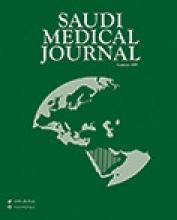Abstract
OBJECTIVE: To assess the presentation, different surgical modalities and their outcome in the treatment of polycystic ovarian disease.
METHODS: A retrospective study was carried out on 66 patients with polycystic ovarian disease. The majority of the cases had a history of infertility for at least 2 years and were known to be clomiphene citrate resistant in the Saudi German Hospital, Jeddah between 1994 and 1998 undergoing laparoscopic ovarian drilling.
RESULTS: More than 80% of the patients were below 30 years of age. The majority of cases below 30 years had primary infertility. Irregular cycle was the main clinical presentation in 75% of cases; ovarian volume was more than 5.5cm3 in all of the cases. Diathermy drilling was carried out for 50 patients, laser for 12 patients and wedge resection for 4 patients. The follow-up treatment showed that pregnancy rate was 23%, 38% and 0% in the 3 groups. Cases that failed to conceive had significantly higher luteinizing hormone level.
CONCLUSION: Laparoscopic ovarian drilling using diathermy or laser is effective during the induction of ovulation and increases the pregnancy rate in cases of polycystic ovarian disease resistant to clomiphene citrate.
- Copyright: © Saudi Medical Journal
This is an open-access article distributed under the terms of the Creative Commons Attribution-Noncommercial-Share Alike 3.0 Unported, which permits unrestricted use, distribution, and reproduction in any medium, provided the original work is properly cited.






